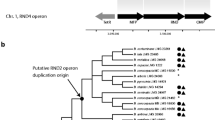Abstract
The mdr1 gene, first member of the human multidrug-resistance gene family, is a major gene involved in cellular resistance to several drugs used in anticancer chemotherapy. Its product, the drug-excreting P-glycoprotein, shows a bipartite structure formed by two similar adjacent halves. According to one hypothesis, the fusion of two related ancestral genes during evolution could have resulted in this structure. The DNA sequence analysis of the introns located in the region connecting the two halves of the human mdr1 gene revealed a highly conserved poly(CA) · poly (TG) sequence in intron 15 and repeated sequences of the Alu family in introns 14 and 17. These repeated sequences most likely represent “molecular fossils” of ancient DNA elements which were involved in such a recombination event.
Similar content being viewed by others
References
Britten RJ, Baron WF, Stout DB, Davidson EH (1988) Sources and evolution of human Alu repeated sequences. Proc Natl Acad Sci USA 85:4770–4774
Bullock P, Miller J, Botchan M (1986) Effects of poly[d(pGpT) · d(pApC)] and poly[d(pCpG) · d(pCpG)] repeats on homologous recombination in somatic cells. Mol Cell Biol 6:3948–3953
Callen DF, Baker E, Simmers RN, Seshardri R, Roninson IB (1987) Localization of the human multiple drug resistance gene, MDR1, to 7q21.1. Hum Genet 77:142–144
Chen CJ, Chin JE, Ueda K, Clark DP, Pastan I, Gottesman MM, Roninson IB (1986) Internal duplication and homology with bacterial transport proteins in the mdr1 (P-glycoprotein) gene from multidrug-resistant human cells. Cell 47:381–389
Chen CJ, Clark D, Ueda K, Pastan I, Gottesman MM, Roninson IB (1990) Genomic organization of the human multidrug resistance (MDRI) gene and origin of P-glycoproteins. J Biol Chem 265:506–514
Fishel RA, Detmer K, Rich A (1988) Identification of homologous pairing and strand-exchange activity from a human tumor cell line based on Z-DNA affinity chromatography. Proc Natl Acad Sci USA 85:36–110
Gaillard C, Strauss F (1994) Association of poly(CA) · poly(TG) DNA fragments into four-stranded complexes bound by HMG1 and 2. Science 264:433–436
Gottesman MM, Pastan I (1993) Biochemistry of multidrug resistance mediated by the multidrug transporter. Annu Rev Biochem 62:385–427
Lancillotti F, Lopez MC, Arias P, Alonso C (1987) Z-DNA in transcriptionally active chromosomes. Proc Natl Acad Sci USA 84: 1560–1564
Liu QR, Chan PK (1990) Identification of a long stretch of homopurine · homopyrimidine sequence in a cluster of retroposons in the human genome. J Mol Biol 212:453–459
Pauly M, Kayser I, Schmitz M, Ries F, Hentges F, Dicato M (1995) The human mdr1 (multidrug-resistance) gene harbours a long homopyrimidine · homopurine sequence next to a cluster of Alu repeated sequences in intron 14. Gene 153:299–300
Pépin L, Amigues Y, Lépingle A, Berthier JL, Bensaid A, Vaiman D (1995) Sequence conservation of microsatellites between Bos taurus (cattle), Capra hircus (goat) and related species. Examples of use in parentage testing and phylogeny analysis. Heredity 74:53–61
Sambrook J, Fritsch EF, Maniatis T (1989) Molecular cloning. A laboratory manual, 2nd ed. Cold Spring Harbor Laboratory Press, Cold Spring Harbor, NY
Sanger F, Nicklen S, Coulson AR (1977) DNA sequencing with chainterminating inhibitors. Proc Natl Acad Sci USA 74:5463–5467
Treco D, Arnheim N (1986) The evolutionarily conserved repetitive sequence d (TG · AC)n promotes reciprocal exchange and generates unusual recombinant tetrads during yeast meiosis. Mol Cell Biol 6:3934–3947
Ueda K, Cardarelli C, Gottesman MM, Pastan I (1987) Expression of a full-length cDNA for the human “MDRI” gene confers resistance to colchicine, doxorubicin, and vinblastine. Proc Natl Acad Sci USA 84:3004–3008
Wahls WP, Wallace LJ, Moore PD (1990) The Z-DNA motif d(TG)30 promotes reception of information during gene conversion events while stimulating homologous recombination in human cells in culture. Mol Cell Biol 10:785–793
Weber JL, May PE (1989) Abundant class of human DNA polymorphisms which can be typed using the polymerase chain reaction. Am J Hum Genet 44:388–396
Zuckerkandl E, Latter G, Jurka J (1989) Maintenance of function without selection: Alu sequences as “cheap genes.” J Mol Evol 29: 504–512
Author information
Authors and Affiliations
Additional information
Correspondence to: M. Pauly
Rights and permissions
About this article
Cite this article
Pauly, M., Kayser, I., Schmitz, M. et al. Repetitive DNA sequences located in the central region of the human mdr1 (multidrug resistance) gene may account for a gene fusion event during its evolution. J Mol Evol 41, 974–978 (1995). https://doi.org/10.1007/BF00173178
Received:
Accepted:
Issue Date:
DOI: https://doi.org/10.1007/BF00173178




